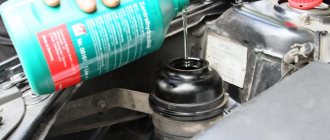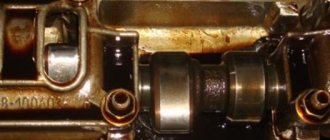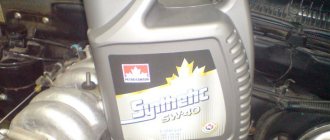Published: 10/20/2020
- Checking the level and topping up
- Technical characteristics of Lada Largus
- Step-by-step instruction
- Oil change video
- Changing engine oil of a different brand
- Characteristics of gearboxes in different modifications of Lada Largus
- Step 2. Filling with new oil
- Checking the oil level
- When to change the oil in the box of Lada Largus
- Oil change intervals
- see also
- How to fill oil in a Lada Largus gearbox
- Oil change instructions
- What kind of oil should I use?
- Causes and signs of oil losing its properties
- Oil change interval for Lada Largus gearbox
- Step 1: Drain the used oil from the gearbox
- How to check the level and top up?
- Let's sum it up
Checking the level and topping up
Before changing or adding lubricant, you should check the oil level in the box. This is not as difficult to do as many may think. If you have minimal experience and skills, you can easily cope with the task with your own hands. In the case of a Lada Largus car, for work you will need to take:
- a syringe that will be used to add the missing liquid;
- rags;
- an empty container for several liters;
- key square for 8;
- oil similar to what is in the box.
Special syringes are used, available in auto parts stores. Do not confuse them with medical syringes, which are not suitable for such purposes. Special topping and filling tools have a hose that allows easy access to the filler neck. When everything is ready, you can begin to assess the amount of oil in the box and add the missing amount of lubricating fluid to the Largus gearbox.
The work is carried out according to the following algorithm of actions:
Remove the engine protection. People often call it the central mudguard. The essence does not change from the name. Find the filler plug, which can often be easily unscrewed with a square wrench. Before opening the cap, place an empty prepared container under it to avoid spilled puddles of oil. According to the standards, the level should be located slightly below the filler hole. If it is less, then you will need to add the missing amount of gear lubricant. A syringe pre-filled with oil is inserted into the filler neck. Gradually pour in the viscous liquid. At some point, lubricant will begin to flow through the hole.
Wait until it stops running completely, then wipe everything with a rag and screw the plug back into place. During the process of checking and topping up, pay attention to the condition of the rubber O-ring on the plug. If the machine is used for a long time and actively, the ring may wear out
It is better to replace it immediately, since a worn seal will break the seal and the oil will gradually leak out. Such a ring costs about 5 - 10 rubles, so serious expenses for such repairs will not be required.
If you did everything correctly, the oil is not leaking anywhere and the gearbox is functioning normally, then the transmission fluid level is sufficient and you can continue to operate your car.
Technical characteristics of Lada Largus
In technical terms, the station wagon has a decent chassis with a McPherson front suspension with wishbones and an anti-roll bar. At the rear there is an H-shaped beam on trailing arms. There are ventilated disc brakes at the front and drum brakes at the rear with optional ABS.
Powertrains of the Lada Largus include two 1.6-liter petrol options from Renault:
- 1. Motor K7M 710 with 84 hp;
- 2. Engine K4M 697 with a power of 102 hp.
The station wagon equipment is complemented by:
- power steering;
- three-point seat belts;
- front electric windows;
- front and side airbags;
- Isofix child car seat fastening system.
Step-by-step instruction
Changing the oil in the box is carried out on a well-warm-up car.
Important! The temperature of the transmission fluid in the box of the Lada Largus should be 60 degrees. Determined by a special device - a scanner
If this is not the case, the car warms up to the operating temperature of the internal combustion engine. The gearbox lubricant temperature will correspond to 60 degrees. This will facilitate good oil drainage. Fig 3
It is determined by a special device - a scanner. If this is not the case, the car warms up to the operating temperature of the internal combustion engine. The gearbox lubricant temperature will correspond to 60 degrees. This will facilitate good oil drainage. Fig 3
- For access and convenience, we drive the car onto an overpass or inspection hole.
- Apply the parking brake.
- We turn on the transmission.
- We go down into the inspection hole and remove the engine protection. Six 10mm bolts.
- Unscrew the plastic filler plug by hand. Using a special four-sided wrench, remove the drain plug.
- Drain the oil into the prepared container. If there were no leaks, we get approximately 2.5-2.8 liters of waste. The full volume of 3.1 liters cannot be drained due to the design features of the upper row of gears.
- We replace the sealing washer with a new copper or aluminum one.
- We wipe the drain neck with a rag and screw the clean plug back on. Tighten with a force of 30 Hm. We use a torque wrench. If there is no key, tighten the wrench tightly enough to avoid possible oil leaks. But not too much, so as not to spoil the edges and break the thread.
- Using a syringe, fill in new transmission fluid through the filler hole. If you don’t have a syringe, take a hose with an outer diameter of no more than 16 mm and a funnel. Open the hood of the car and, through the top, insert the hose into the filler neck.
- Fill with oil until grease flows out of the same hole. The filler hole is also a control hole. The lower level, which is the norm. Before tightening the filler plug, inspect the sealing rubber for integrity.
- If necessary, to eliminate smudges, replace the rubber band or plug assembly with a new one. We start the car for a few minutes. Then we inspect the gearbox for oil leaks.
- Reinstall the engine protection.
- To carry out work on replacing the gearbox lubricant of a Lada Largus car, you can turn to professionals or do the work yourself.
Is it worth changing the oil in manual transmissions at all - video
Process of draining waste
Before you begin, you need to prepare the necessary materials yourself. Namely:
- Transmission fluid;
- Oil filter;
- The key is set to “10” and the tetrahedron is set to “8”;
- Clean rags;
- Container for draining waste with a capacity of at least 5 liters;
- A brush, preferably a metal one.
The work is performed on a warm engine. After a short trip, you need to drive the car onto an overpass. First, unscrew the filler cap. Then use a wire brush to clean the drain plug. It is located on the underside of the engine crankcase. When unscrewing the cap, you must be especially careful so as not to get burned. Drain the waste into the prepared container. This will take 10-15 minutes. Degrease the plug and screw it back on.
Another important point: the steel washer located under the plug requires replacement if the rubber gasket is damaged.
Oil change video
Are you the owner of Lada Largus? Well, that’s great, because although this model appeared on the market relatively recently, it has already proven itself to be the best, especially in terms of transporting small cargo when running a small business or for family trips. However, as you know, in order for your car to serve you for a long time and reliably, you need careful care.
In any car, the gearbox is one of the leading units, and a lot depends on whether the oil in the gearbox is changed on time. At the same time, every time you need to change the oil, contacting a qualified service or service station will be very expensive for you, since it implies large financial costs. Therefore, it will be much more profitable for you to change the oil yourself. First of all, you need to periodically check the oil level in the gearbox, but at least once every 15,000 km. True, sometimes there are cases when such a check should be done more often; one of such cases may be the case when, in the case of repairing a gearbox, it was necessary to switch to oil of a different viscosity; in addition, there are other cases. For Largus, it is recommended to fill the gearbox with TRANSELF TRJ 75W-80 oil.
Your attention should be focused on the fact that, both for the JR5 type gearbox and the JHZ type gearbox, the oil change is carried out in a similar way. Insufficient oil level in the gearbox may result in insufficient clarity of gear shifting, extraneous noise, etc.
To change the oil in the Lada Largus gearbox you will need: an 8 mm square wrench, a syringe for filling transmission units
In order to change the oil, you need to loosen the drain plug. Next, unscrew the plug and drain the oil into a container. The seal on the plug is a copper washer; if the washer is too compressed, you should replace it. If you do not have a square wrench to unscrew the plug, you can sharpen the M10 bolt. After this, you need to unscrew the plug and add oil.
To change the oil in the Lada Largus gearbox, you will need: an 8 mm square wrench and a syringe for filling transmission units. In order to change the oil, you need to loosen the drain plug. Next, unscrew the plug and drain the oil into a container. The seal on the plug is a copper washer; if the washer is too compressed, you should replace it. If you do not have a square wrench to unscrew the plug, you can sharpen the M10 bolt. After this, you need to unscrew the plug and add oil.
According to the manufacturer's instructions, Largus engine oil must be changed every 15 thousand km. Depending on operating conditions, more frequent changes are possible (every 7-8 thousand km). The filter also needs to be changed.
The Lada Largus is available with two types of engine models: 8-valve K7M and 16-valve K4M. The volume of motor lubricant to be filled for different models is 3.3 liters and 4.8 liters, respectively.
The choice of motor fluid must be approached responsibly. The operation of the internal combustion engine directly depends on this consumable. The factory initially fills it with ELF SOLARIS RNX 5W-30. Also, the recommended oils have API class SL, SM, SN. Experts also suggest using ACEA quality class A1/ A2/ A3/ A5. The viscosity level also matters. According to the SAE classification, we choose 5W30.5W40, 0W30, 0W40. It all depends on the climate of the area.
Changing engine oil of a different brand
If you decide to change the brand of oil, flush the lubrication system with flushing oil or oil of the brand that will be used. To do this, after draining the old oil, fill in new oil to the bottom mark of the oil dipstick. Start the engine and let it idle for 10 minutes. Drain the oil and only then replace the oil filter. Now you can fill in new oil up to the top mark on the dipstick.
Let us remind you that pay special attention to choosing high-quality motor oil. Keywords: lubrication system Lada Largus | Lada Largus engine | Lada Largus filters
Keywords: lubrication system Lada Largus | Lada Largus engine | Lada Largus filters
3
3
Found an error? Select it and press Ctrl+Enter..
Installing a new filter
First of all, it is necessary to remove the protection on the engine (for K4M, 16 valves). To do this, you need to unscrew six screws with a “10” key. The filter part is removed counterclockwise. The container for drainage should be ready. If you don't have a special tool to remove the filter, you can use a screwdriver as a lever.
Now fill the new filter about 1/3 full with grease, lubricate the O-ring and install it in place.
Pouring new motor substance into a Lada car
Pour the prepared lubricant through the oil filler neck. The quantity depends on the engine type (16- or 8-valve). The dipstick will indicate the level of the filled substance. The mark should be halfway between the maximum and minimum values.
Now you need to warm up the engine at idle speed. Approximately 3 minutes after starting the engine, the emergency light will go off. If oil leaks are not found anywhere, then everything has been done correctly. After turning off the engine, check the level of the filled consumables again. If necessary, top up to the appropriate rate. The norm for 16 and 8 Lada engine models is determined the same way.
Characteristics of gearboxes in different modifications of Lada Largus
The above models of gearboxes have various modifications designed for installation on certain machines. For example, the JR5 517 gearbox is installed on a van with K4M and K7M engines. The JR5 549 is combined with the K4M engine in both a five- and seven-seat van. The JR5 551 gearbox works with the eight-valve engine on the station wagon, and the JH3 540 modification is usually installed in the five-seater Largus with an eight-valve engine.
Both gearbox models are made of an aluminum alloy housing, in which are mounted:
- differential;
- final drive gear;
- clutch housing.
Inside the Lada Largus gearbox housing there is a primary shaft with a set of drive gears and a secondary shaft with driven gears located next to it. To ensure coordinated operation of the primary and secondary shafts, synchronization rings are installed on them. The difference between the variations of speed boxes lies in the gear ratios between the primary and secondary shafts. The difference between the JH3 and JR5 models is the design of the clutch and gear shift control.
The clutch on the JH3 unit is controlled via a cable connected to the clutch pedal, and gear shifting in the box occurs via a rod connected to the gearshift knob.
In the JR5 model, the transmission of force to the release bearing is carried out by a hydraulic system, which includes the main and working cylinders. The gearbox is controlled by two cables connected to the gear shift knob. At the same time, the cables are not interchangeable; each of them has its own functional purpose.
Before deciding on the purchase of a gearbox, it is necessary to evaluate the features of the automatic and manual transmission. A car with an automatic transmission has a number of advantages over a manual transmission, but it also has undeniable disadvantages.
Advantages and disadvantages of automatic transmission Lada Largus
| Advantages | Flaws |
| Excellent handling | Expensive repairs |
| Good acceleration dynamics | Frequent malfunctions |
| Multiple speed shift modes | High price |
| Ease of driving in urban environments | Inability to start the car when the battery charge is low (from a pusher) |
Therefore, before buying a Lada Largus with automatic transmission, you should weigh the pros and cons. In particular, it is necessary to understand in what conditions the car will be used most often.
Checking the oil level
Checking the level of the substance in the transmission occurs in several stages. For this purpose, the car has a special plastic probe. This unit has special marks that show the current fluid level. This part is located on the body in the engine compartment. To check the oil level of the Largus transmission, you need to open the hood and remove this dipstick. After this, you need to wipe with a dry cloth, insert and remove again. The level of the substance at the dipstick mark will correspond to the actual level. If this indicator drops critically, it is necessary to top up the product to the optimal value and inspect the box for any faults.
When to change the oil in the box of Lada Largus
Lada Largus is a redesigned station wagon from the French-Romanian company Dacia, built on the B0 platform. The car has already proven itself on the positive side as reliable and unpretentious in maintenance. It has two engine options with 8 and 16 valves. In Russia it is presented with a 5-speed manual gearbox made in France. Regarding the gearbox, this car also does not cause any particular complaints - the service life of the unit declared by the manufacturer is 200 thousand km, however, there are cases where the unit has been maintained for long distances without major repairs or replacement. To extend the life of the unit, avoid breakdowns and maintain correct operation, it is necessary to regularly change the transmission.
In this matter, the manufacturer previously held the opinion that there was no need for such a change at all, since the oil filled at the factory was designed for the entire service life of the unit. However, in 2014, recommendations regarding the procedure for changing the fluid were received by the owners. Such an interval was determined only once at 140 thousand kilometers, while the timing without taking into account mileage was not indicated at all. Taking into account the indicated mileage, this procedure does not fall under the mileage warranty period and, accordingly, in financial matters falls entirely on the consumer.
Moreover, prior to the release of these recommendations, experienced drivers, both previously and currently, have their own schedule for such replacement. Most often they rely on a mileage of 60-70 thousand km or once every 4 years, regardless of mileage. Also, when changing the transmission, the oil filter is also replaced.
5 manual transmission (JR5)
Available configurations and prices
If a five-speed manual transmission is enough for comfortable driving around the city or on the highway, then you can safely choose the option with a manual transmission5. This unit is identified by the code JR5 according to the Renault company classification. This transmission is equipped with cars in the “Life” (basic configuration) and “Drive” modifications with front-wheel drive and a 1.6-liter engine. The cost is 1,015,000 rubles. and 1105990 rub. respectively.
Specifications
JR5 has been designed by the company's engineers for a long time and has been successfully used on other Renault, Lada and Nissan models for many years. Therefore, it was decided to use it on the new representative of the model range.
Gear ratios
One of the main characteristics of the transmission is rightfully the gear ratio in each gear. Below are the data for 5 manual transmission.
- 3,727.
- 2,048.
- 1,321.
- 0,971.
- 0,738.
Design
This gearbox was not created from scratch. The basis was taken from an old design marked JH3 and reworked to suit modern needs. The basis remains the same: a two-shaft arrangement using synchronizers in all stages and combining with the main gear and differential into one system.
Among the improvements made by engineers, experts note:
- Installation of a hydraulic clutch, which replaced the use of a cable. By such actions, a softer moment of changing gear stages was achieved.
- Direct activation is now carried out by two flexible cables, and not by a rigid rod, as before. This made it possible to remove vibrations inside the unit.
- The Renault Arcana manual transmission in 5 gears can withstand 200 Nm, while its predecessor only 160. The difference of almost 25% is quite noticeable.
The working cylinder and bearing are combined into one unit and bolted to the crankcase.
Most of the box is made of aluminum and steel alloys. High-quality sealants are used to seal the product. The teeth of the reverse gears are different - they are straight, not oblique, as for all the other five. Different types of secondary shaft bearings are used, namely ball and roller.
Exploitation
Resource
According to Renault company representatives, the service life of the JR5 gearbox without repairs or breakdowns can be 250 thousand kilometers. After this, if not earlier, of course, adventures will begin in the form of repairs or replacement of individual components. To prevent this from happening, you need to keep an eye on the box. The first thing is to change the oil on time, do not overload in cold or very hot seasons, and do not transport cargo more than allowed in the technical specifications. In practice, with a gentle operating mode without major repairs, it turns out to “run back” twice as much
Change of oil
According to the scheduled list of replacement works, a mask is not provided for in the Renault Arcana manual transmission. But service center specialists insist on changing the fluid every 60 thousand mileage. The procedure will not cost the owner very much, but will significantly extend the life of the unit. To change, you need to use branded oil ELF Tranself NFJ 75W80. For a complete replacement, 2.5 liters will be enough.
Consumption
Let us remind you that only front-wheel drive Renault Arcana with a 1.6-liter engine are equipped with a manual transmission5. According to the passport data, the consumption should be 7.1 liters of AI-95 gasoline. In practice, the indicator may be higher or lower depending on various factors.
The Renault Arcana 5-speed manual transmission is not a new development, but an improved unit. Therefore, all serious shortcomings in it have been eliminated long ago. Of those that are relevant
It can still be noted: Frequent and constant oil seal leaks.
Oil change intervals
Unlike an automatic transmission, in which ATF plays the role of a working fluid, in a manual transmission the oil serves to remove heat and reduce wear on rubbing pairs. But even in this mode of operation, irreversible chemical and physical processes occur; the oil is filled with a suspension of wear products from rubbing metal surfaces. Such negative factors reduce the life of synchronizers and gears. Therefore, it is still necessary to change the oil in manual transmissions, despite Renault service recommendations.
We recommend making the first replacement at 60 thousand km. During the first tens of thousands of kilometers of a vehicle's run, parts are worn in inside the gearbox. After the break-in period, the amount of wear products in the oil decreases, so the interval between subsequent replacements can be increased to 80-100 thousand km.
see also
Comments 30
I replaced the 5th gear gear and after 1500 km I changed the oil and filled it with Mobile 75-90. Until I changed the oil on the 5th there was not much noise, after the change everything was fine.
Immediately after buying the car, I bought the same three liters, but never changed the oil in the box. As a result, I’m thinking of changing it to 75w90 oil, most likely mobilube or motul gear 300.
I decided to fill the Renault box with Renault oil :)
I changed mine at about 24,000 km, everything was fine before, after the replacement, I can say that the gears immediately began to turn on poorly, that is, worse than before. Now the mileage is 39,000 km, sometimes it is impossible to turn on the first one, I turn it on through the second one. If the first one does not turn on, then I turn on the second one and quickly start the first one. The remaining gears are engaged but with noticeable resistance. I suspect underfilling of oil. I remember when I was changing it, I drained about 2.5 liters, but only filled in 2, it didn’t fit anymore, but somehow I didn’t attach much importance to it, I took 5 liters, I thought that if something else then I’ll add more. Then, long after the replacement, I accidentally watched a video where it turns out that it seems necessary to jack up the left side of the car and then the oil will fill completely. I recently bought 3 liters of fresh one, I’ll be changing it again soon. The 3 liters that I had left from the last replacement went to the chainsaw)))
Let me know when you change it again. I filled it to the level until it leaked out of the filler neck. The car was parked on a level surface
Mine was also level, I filled it until it started leaking. I'll definitely let you know. Subscribe to my car, and then you will see my blog entry in your feed. I will most likely do a report next week, I will finish the repairs in the garage.
I changed mine at about 24,000 km, everything was fine before, after the replacement, I can say that the gears immediately began to turn on poorly, that is, worse than before. Now the mileage is 39,000 km, sometimes it is impossible to turn on the first one, I turn it on through the second one. If the first one does not turn on, then I turn on the second one and quickly start the first one. The remaining gears are engaged but with noticeable resistance. I suspect underfilling of oil. I remember when I was changing it, I drained about 2.5 liters, but only filled in 2, it didn’t fit anymore, but somehow I didn’t attach much importance to it, I took 5 liters, I thought that if something else then I’ll add more. Then, long after the replacement, I accidentally watched a video where it turns out that it seems necessary to jack up the left side of the car and then the oil will fill completely. I recently bought 3 liters of fresh one, I’ll be changing it again soon. The 3 liters that I had left from the last replacement went to the chainsaw)))
Read more: Pump nsh 50 characteristics
I would like to know what oil is filled now and what kind you will fill... Oil for manual transmission - Choice: www.drive2.ru/l/509881750902539127/
From the factory, the engines of my 2012s were filled with ELF, the one above at the beginning of the entry in the photos, I bought myself exactly 3 of these, liters each. Before this, I used the same ELF, only a 5 liter canister.
I have already spoken on various topics, at the Auto Exhibition in Moscow, AvtoVAZ employees said, if there is noise, play with the oil...
I agree with you, recently in my UAZ, at high speeds (70+), the 5th gear began to howl. I suspected that there was no oil in the transfer case because... a little dripped from it. It turned out that there was no oil not only in the transfer case but also in the gearbox. Filled it up, the howling disappeared, the gears began to engage like on a passenger car, and before that like on a tractor)). In general, I got off easy because I started fussing during the time, well, like during the 2 weeks, then I drove around with a howl, it turns out that without oil. But this is UAZ, and this is Renault.
Oil tends to lose its intended properties, few people think about it... that is, to burn out, when I drove Estima I changed the automatic transmission oil every 15 tkm, and if I drove more, I would have ruined the box... after 15 tkm the automatic transmission growled and screamed -silk... and before this run, there was almost* silence...
Well, an automatic transmission requires a much more detailed selection of oil and its replacement intervals than a manual transmission.
The boxes have the same purpose, but with different capabilities, but the driving style is different for everyone, from here, and the manufacturer makes gearbox oil - GL-4 and GL-5... - translated: for speed and moderate driving...
I also changed the oil in the manual transmission at 10,000 km and immediately in the engine, it became much quieter and the shifts became better, although there were no problems before, the car drives differently, which means that the ros-and-oil needs to be replaced - with good oil, especially for manual transmission!
There is a difference for the better!
Not that word. Even the sound of all components has changed - on the move...
I also changed the oil in the manual transmission at 10,000 km and immediately in the engine, it became much quieter and the shifts became better, although there were no problems before, the car drives differently, which means that the ros-and-oil needs to be replaced - with good oil, especially for manual transmission!
Read more: How to increase the ground clearance of a VAZ 2110
I support, I did the same, changed everything to Motul...
Changing the oil in the Lada Largus gearbox, according to the manufacturer, should not be carried out until the resource is exhausted. But many car enthusiasts perform this operation in order to replace the oil fluid with a different viscosity or when repairing a gearbox.
How to fill oil in a Lada Largus gearbox
The procedure for changing the transmission does not seem technologically complex. With certain skills, as well as a lift and a set of keys, almost any car enthusiast can do it. However, official services are also willing to take on this work. Given the long change intervals, in addition to lubricants, it is necessary to purchase an original oil filter. In addition, depending on the type of replacement, this procedure can last from half an hour to 2 hours.
Complete oil change in the box of Lada Largus
A complete fluid change involves a procedure with several stages, during which the used fluid is completely replaced with a new one:
- The unit body is checked for leaks and fogging, and the liquid level is also checked using a dipstick.
- After this, the car is raised on a lift, a container is placed for draining and the drain plug is unscrewed. By gravity, such a substance will completely drain within 1-2 hours.
- A new one is installed in place of the old filter.
- After this, fill in a new product at the level in accordance with the marks on the dipstick.
Then you need to start the engine and change all gears sequentially. In this case, there should be no parasitic vibrations, hum, buzzing and other negative factors during switching and operation of the transmission.
Partial oil change in the Lada Largus gearbox
A partial change of fluid is represented by simply topping up the mark on the dipstick to the required level or by partially changing the substance. When changing, you need to lift the car on a lift, unscrew the drain plug and drain the waste material. After this, use a funnel to pour the required lubricant into the crankcase to the required level.
You should also replace the oil filter even with a partial change. This procedure is carried out when leaks are detected and fogging of the gearbox housing.
And a little about the author’s secrets
My life is not only connected with cars, but with repairs and maintenance. But I also have hobbies like all men. My hobby is fishing.
I started a personal blog in which I share my experience. I try a lot of things, different methods and methods to increase my catch. If interested, you can read it. Nothing extra, just my personal experience.
Attention, TODAY only!
The joint production of AvtoVAZ and Renault equipped Lada Largus cars with five-speed gearboxes. Depending on the configuration, gearboxes marked JR5 and JH3 are installed.
On more common versions with a 1.6-liter 8-valve engine and a 1.6-liter 16-valve engine, a JH3 manual transmission is installed.
The maintenance regulations do not provide for changing the oil in the Lada Largus gearbox. Although cars are adapted for harsh operating conditions, it is recommended to carry out lubricant diagnostics every 15,000 km.
This is done using a visual inspection. It is enough to unscrew the filler plug at the end of the box closer to the cooling radiator.
Oil change instructions
1. Place the machine on a level surface.
2.Unscrew the engine and transmission crankcase protection. In some variations, the protection has a technological hole for unscrewing the drain plug.
3. Clean the gearbox housing from dirt and dust in the drain area and near the filler hole. If drained oil is to be reused, the area near the drain plug must be clean.
4.Unscrew the drain plug using a 8-square. After loosening it with a wrench/ratchet, we recommend turning the plug out manually to quickly remove it from the stream of draining waste. An increase in backlash indicates the end of the thread.
If the color of the drained oil is cloudy, with an emulsion, then there are water impurities in the oil.
5.Use pliers to unscrew the filler plug, which is located at the end of the right side of the box. It is not necessary to change the gasket on this plug.
6.Tighten the drain plug. It is advisable to replace the sealing gasket.
7. To fill in new oil, use a homemade funnel with a piece of hose or a special syringe for filling technical fluids. First pass the hose through the top of the engine compartment, and then direct it from below into the filler hole.
Pour oil into the box until it flows out of the filler hole. The same method is used for in-line level checking. As soon as the oil has stopped flowing out of the filler hole (which is why the car is placed on a flat surface), tighten the plug by hand, wipe off any oily traces and install the engine protection.
Something else useful for you:
Before starting work, travel at least 10-15 km so that the oil inside the gearbox warms up and becomes less viscous. If the sealing gasket of the filler plug is not torn, elastic, it can be reinstalled
Pay attention to the processing status. The presence of an emulsion indicates mixing of oil and water
Often such a nuisance is a consequence of a leak in the boot of the inner CV joint of the left drive shaft. Therefore, inspect the boot for tears or loose clamps. Pay attention to the transmission breather, through which, if installed incorrectly, water and dirt enter the manual transmission. Often, after unqualified repairs, craftsmen neglect the correct installation of the breather. 4.For preventive purposes, rinse and blow out the breather with compressed air. As the pressure inside the transmission increases, a completely clogged "breather" valve can push out. If the malfunction is not noticed in time, dust, dirt and moisture will render the new gear oil unusable.
Seal
The Russian model Lada Largus, thanks to its unsurpassed carrying capacity among its classmates and enviable spaciousness, has long gained fame among owners not only in the domestic market, but in other countries. This success was facilitated by the presence in the arsenal of a practical station wagon of balanced technical capabilities and decent reliability of most components.
To maintain a Lada Largus car with a 16-valve engine, like any other, in good condition, it is necessary to adhere to timely replacement of the entire list of consumable components and liquids. Among these items, a special place is given to oil in the transmission unit. And therefore, many owners are interested in the question of what oil to use. The manufacturer, for its part, assures that this liquid cannot be replaced until its full service life is reached. However, the realities of operation sometimes make adjustments, which implies the need to intervene in the unit earlier than the designated period. In most cases, such a necessary action is dictated by repair work in the box or its premature wear, implying a complete replacement of the unit.
What kind of oil should I use?
On the assembly line, the manufacturer fills the manual transmission with Elf Tranself NFJ 75W-80, which Renault recommends for transmissions of the JXX, TL4 and NDX series.
Renault Logan, Sandero, Logan 2, Lada Largus with 1.4 liter engines were equipped with a jH1 manual transmission, while cars with 1.6 and 1.2 liter engines were equipped with a jH3. Structurally, the units differ in the size of the clutch housing, so this does not affect the choice of gear oil. Less common on cars is the JR5 manual transmission.
For topping up, use only Elf Tranself NFJ 75W-80, since mixing oils is not prohibited. For a complete replacement, it is not necessary to buy original products. You can choose among worthy analogues:
- Liqui Moly Getriebeoil 75W-80 (GL-5);
- Castrol Syntrans Transaxle 75W-90 (GL-4+);
- Motul Motylgear SAE 75W-80 (GL-5);
- Castrol Syntrans V FE 75W-80 (GL-4+);
- Shell Getriebeoil EP 75w90 (GL-4);
- Valvoline Maxlife MTF SAE 75W-80 (GL-4).
The filling volume of gearboxes jH1 and jH3 is 2.8 l, JR5 is 2.5 l. Before purchasing, we recommend that you check this information in the repair and operating manual for your car model.
Criterias of choice
When choosing transmission fluid, pay attention to the specification and viscosity. The API classification is a generally accepted classification that, through testing, determines the effectiveness of extreme pressure and anti-corrosion additives. Elf Tranself NFJ 75W-80 corresponds to the GL-4+ class, which is recommended for use in synchronized manual transmissions of passenger cars. However, it is permissible to use GL-4 and the highest class - GL-5, which is designed for loaded hypoid gears.
The SAE marking shows low-temperature (number with index W) and high-temperature characteristics. 75W formulations are recommended for regions where the temperature does not drop below -40°C. If the car is operated at temperatures not lower than -26°C, oils with an index of 80W are poured into the manual transmission. As for high-temperature characteristics, in regions with a temperate climate, a viscosity grade of 85-90 can be used.
For Renault Logan, Sandero, Logan 2, Sandero 2, Lada Largus, you can safely use oils with SAE indexes: 75W-80, 75W-90, 75W-85 and an API specification of at least GL-4.
Causes and signs of oil losing its properties
If the transmission fluid is darkened or black in color, this may indicate that the lubricant has undergone a chemical change as a result of severe contamination with wear products of the gearbox elements (gear shafts and synchronizers) or a violation of the tightness of the gearbox (moisture and dirt entering through the seals of the drives or input shaft ).
- The smell of burnt oil in Lada Largus. May indicate insufficient lubrication levels due to leaks. Under heavy loads on the unit, cooling of the rubbing parts is not adequately ensured.
- If shifting gears is difficult, you may hear some noise or hum at certain speeds or when idling. The lubricating properties of the transmission fluid are partially lost or the level in the gearbox housing is insufficient.
- Increased wear of gearbox elements. Aggressive driving style and incorrect gear shifting.
- Mileage over 60,000 km since previous replacement. It is at this interval that service stations recommend replacing the transmission fluid.
Let's consider other suitable oils for Lada Largus:
- Castrol Syntrans Transaxle 75W-90 is a synthetic oil, the best analogue among its competitors. In terms of quality and resistance to temperatures, this oil can be compared with the original. After filling with such oil, the gearbox will engage more smoothly and clearly. Owners also note the absence of a crunch when engaging reverse.
- Motul Gear 300 75 W90 is another synthetic oil that gives the gearbox maximum operating efficiency. The properties of this oil have a positive effect on the smoothness and clarity of gear shifting. Crunching and noise are also eliminated
- Shell Getriebeoil EP 75W90 GL4 is frankly not the most suitable oil for Lada Largus. This lubricant is a prime example of the fact that expensive oil is not always the best. There is no doubt about the quality of Shell products, but this product has incompatible parameters with the Lada Largus gearbox, or is simply not adapted for the Russian climate. Largus owners who have tried this oil often complain about hum, noise, vibration and crunching of the synchronizers.
Oil change interval for Lada Largus gearbox
The Lada Largus station wagon went on sale back in 2012. Initially, the manufacturer did not indicate any information on the period for changing the oil in a manual transmission. Arguing this is that the oil is designed for the entire service life of the car and does not require replacement.
In 2014, the maintenance regulations changed, and AvtoVAZ added an item for changing transmission oil in the Lada Largus manual transmission - after 140,000 km. There is no time frame for replacement, only replacement after a certain mileage.
140 thousand kilometers are not covered by the dealer’s warranty, so replacing the transmission oil in the Lada Largus box is entirely the responsibility of the owner.
Although experienced car owners change the oil in the gearbox much earlier - after 60-70 thousand kilometers or after 48 months. In fact, the replacement costs are not so high that it would be worth saving on this to the detriment of the box.
Let's sum it up
In practice, it has been reliably established that procedures such as topping up or changing gearbox oil in a Lada Largus transmission with a 16-valve engine are in no way associated with difficulties. This allows inexperienced owners, without a shadow of a doubt, to resort to such repair actions when the need arises. Note that the factory recommends replacing the fluid after 200,000 miles, although in reality this interval can be significantly reduced. In any case, monitor the level and what kind of oil you are pouring, that is, its condition (color, smell, presence of chips, etc.) of the oil in the transmission after the scheduled interval and then you will have complete information about the real need for replacement or topping up.
How to check the level and top up?
It is recommended to check the lubricant level in the Lada Largus transmission before replacing or topping up. The control procedure itself is quite simple and quickly feasible. Here you will need a minimum of skills and the following list of aids and tools:
- a syringe that allows you to add liquid;
- rags and a container that can hold about three liters;
- square key size 8;
- lubricant, similar in type and origin to that indicated in our material.
If a syringe is not available, it can be freely purchased in stores specializing in auto products. This device should not be confused with medical supplies, which, of course, are absolutely inapplicable in this situation. An addition can be a hose that provides easy access to the filler neck. After preparing the specified funds, you can safely move on to monitoring the level and topping up, if such a need arises as a result of the “monitoring mission”.
For control actions, the following algorithm will be optimal.
We remove the motor protection. Among car enthusiasts, this protective part is called the central mudguard. We find the drain plug of the box and unscrew it using the designated “square” key. Before unscrewing, place a container under the hole. We estimate the level, which, in accordance with regulatory standards, should be located slightly below the lower edge of the filler neck. When this level is less than the designated limit, we top up. To do this, insert the tip (hose) of the syringe into the filler neck and perform the usual action of squeezing the liquid into the unit. We “pump” the box with oil until the return flow of oil begins through this hole. Here we complete the refilling, and carefully wipe the perimeter around the hole with a prepared rag. All that remains is to tighten the plug, which we do without any hesitation. Don't forget to inspect the condition of the sealing ring on the plug. If it is worn out, we replace it
The price issue of this important product is scanty (about 10-15 rubles).
Now you can start operating the car, having first made sure that the gearbox oil is filled and there are no leaks.
What is important besides changing the lubricant in the engine and manual transmission
Many car enthusiasts do not like to look under the hood before changing the lubricant. The fact is that during operation, rubber gaskets and seals can harden and leak oil. As a result, lubricant loss begins in these devices. The level decreases, which leads to strange behavior of the car on the roads and ultimately to major repairs.
To prevent this from happening, experienced mechanics advise:
- every 5,000 kilometers check the lubricant level in the engine;
- Every 30,000 kilometers, check the oil level in the manual transmission.
Such simple measures will save the car owner from wasting money. If necessary, it is recommended to add oil to the gearbox or power unit. The engine and manual transmission are pre-serviced. A technical inspection is needed to detect faults that lead to loss of lubricant.
What harms the normal long-term operation of the rubber parts of the engine and mechanics:
- daily delays in traffic jams. The oil in the power unit and gearbox heats up and then cools down; the oil seals expand and contract at a constant frequency, which leads to their wear. And the lubricant itself quickly loses its properties in this case;
- starting the engine cold;
- Frequent travel over short distances. The liquid does not have time to really warm up. Condensation forms. This happens very often in winter.
And condensation dilutes the lubricant, and it loses its protective properties.











